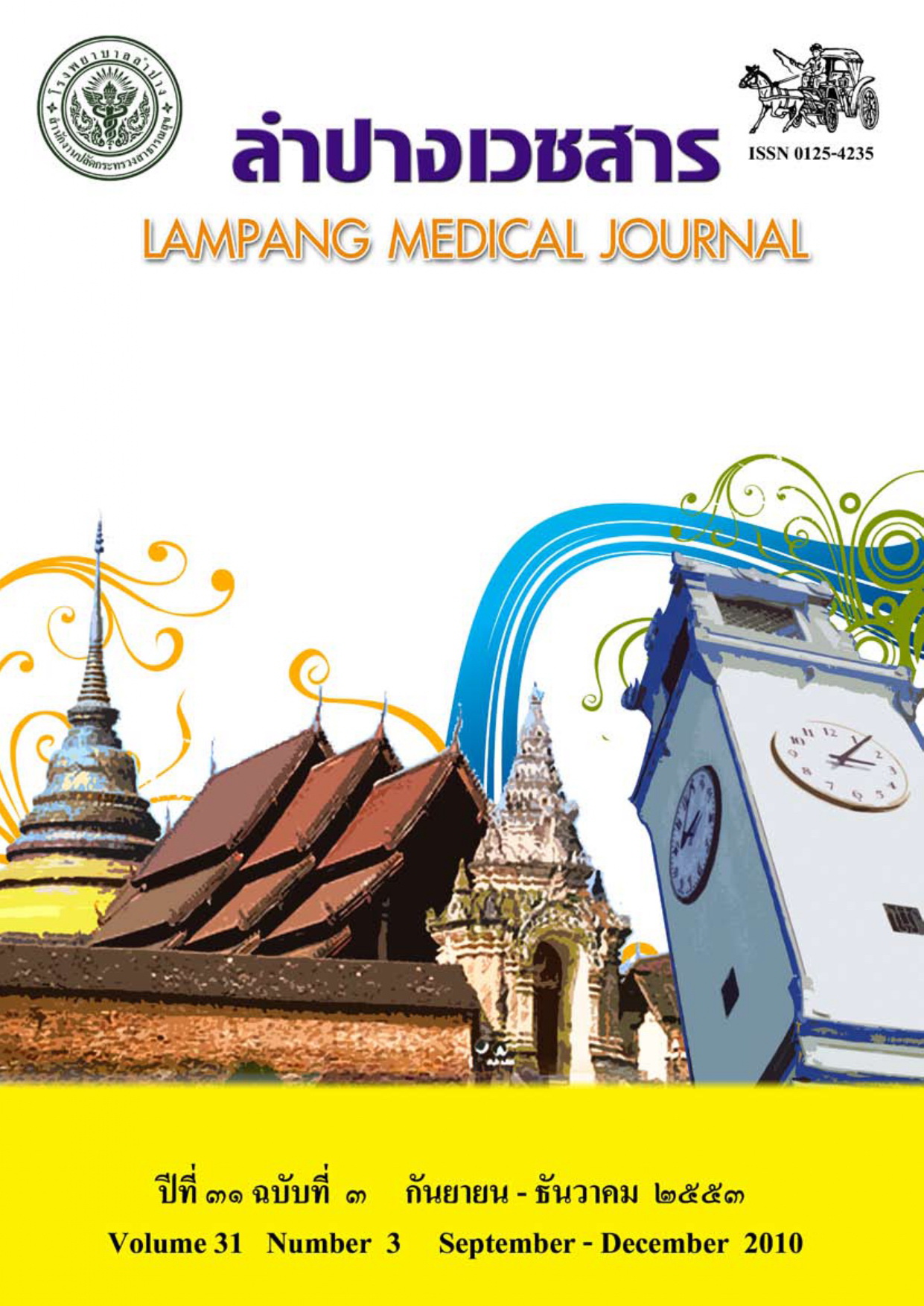Guillain-Barre Syndrome in Lampang Hospital
Main Article Content
Abstract
Background: Guillain-Barre syndrome (GBS) is an acute polyradiculoneuropathy that can cause morbidity and mortality. Clinical data of this syndrome is lacked in Lampang Hospital.
Objective: To study the incidence of GBS and its prognostic factors in Lampang Hospital.
Material and method: An analytic cross-sectional study was conducted on the patients aged above 15 years who were diagnosed with GBS in Lampang Hospital between October 2008 and September 2010. The general data, clinical data, electrodiagnosis and treatment outcomes were retrospectively reviewed. The data was analyzed by descriptive statistics. Odds ratio was calculated
for comparing between the severe (GBS disability score 3-6) and mild groups (GBS disability score 0-2) by using student t-test, Fisher exact test and chi-square test.
Results: Twenty-five patients enrolled the study (M:F = 14:11). The GBS incidence was 5.12 per 100,000 patient-year. The mean age was 46.2 ± 18.6 years. The most common type was acute inflammatory demyelinating polyneuropathy (60%). Fifteen patients were classified as severe group, among these two were died. The factors related to severe condition were preceding diarrhea
(OR=1.91, 95%CI 1.27–2.87, p = 0.032) and initial presentation with respiratory failure (OR=2.67, 95%CI 1.42–5.02, p = 0.002). The severe group significantly had higher cost of treatment (152,103 ± 145,002 baht vs 8,187 ± 3,030 baht, p<0.001). In severe group, four patients who received intravenous immunoglobulin (IVIg) and another four who underwent plasmapheresis significantly had
lower GBS disability score than the patients who had conservative treatment (p=0.002) but the mortality rate was not different. The mortality rate and lowered GBS disability score in IVIg group were not different from the plasmapheresis group.
Conclusion: The incidence of GBS in Lampang Hospital was higher than worldwide incidence. Poor prognostic factors were preceding diarrhea and initial presentation with respiratory failure. IVIG or plasmapheresis in severe case significantly increased the treatment cost but lessened the disability.
Article Details

This work is licensed under a Creative Commons Attribution-NonCommercial-NoDerivatives 4.0 International License.
บทความที่ส่งมาลงพิมพ์ต้องไม่เคยพิมพ์หรือกำลังได้รับการพิจารณาตีพิมพ์ในวารสารอื่น เนื้อหาในบทความต้องเป็นผลงานของผู้นิพนธ์เอง ไม่ได้ลอกเลียนหรือตัดทอนจากบทความอื่น โดยไม่ได้รับอนุญาตหรือไม่ได้อ้างอิงอย่างเหมาะสม การแก้ไขหรือให้ข้อมูลเพิ่มเติมแก่กองบรรณาธิการ จะต้องเสร็จสิ้นเป็นที่เรียบร้อยก่อนจะได้รับพิจารณาตีพิมพ์ และบทความที่ตีพิมพ์แล้วเป็นสมบัติ ของลำปางเวชสาร
References
McGrogan A, Madle GC, Seaman HE, de Vries CS. The epidemiology of Guillain-Barre syndrome worldwide: a systematic literature review. Neuroepidemiology 2009; 32(2):150-63.
Kuwabara S. Guillain-Barré syndrome: epidemiology, pathophysiology and management. Drugs 2004;64(6):597-610.
van Doorn PA, Ruts L, Jacobs BC. Clinical features, pathogenesis and treatment of Guillain-Barré syndrome. Lancet Neurol 2008;7:939–50.
ก้องเกียรติ กูณฑ์กันทรากร. ประสาทวิทยาทันยุค.พิมพ์ครั้งที่ 1. กรุงเทพมหานคร: พราวเพรส (2002); 2553. หน้า 319-62.
Pithadia AB, Kakadia N. Guillain-Barré syndrome. Pharmacological Reports 2010; 62:220-32.
van Koningsveld R, Steyerberg EW, Hughes RA, Swan AV, van Doorn PA, Jacobs BC. A clinical prognostic scoring system for Guillain-Barré syndrome. Lancet Neurol 2007; 6:589–94.
Hughes RA, Cornblath DR. Guillain-Barre syndrome. Lancet 2005; 366:1653–66.
สืบสาย คงแสงดาว. แนวทางการวินิจฉัยและการรักษาโรคระบบประสาทส่วนปลายที่พบบ่อยในเวชปฏิบัติ. ใน: ประเสริฐ ธนกิจจารุ, กิตติ ชื่นยง, สกานต์ บุนนาค, นภา ศิริวัฒนากุล, สถิตย์ นิรมิตรมหาปัญญา, บรรณาธิการ. อายุรศาสตร์ราชวิถี Best practice in clinical medicine 2010. พิมพ์ครั้งที่ 1. กรุงเทพมหานคร:กรุงเทพเวชสาร; 2553. หน้า 177-93.
van der Meche FG, Van Doorn PA, Meulstee J, Jennekens FG. Diagnostic and classification criteria for the Guillain-Barre syndrome. Eur Neurol 2001;45:133–9.
Elovaara I, Apostolski S, van Doorn P, Gilhus NE, Hietaharju A, Honkaniemi J, et al. EFNS guidelines for the use of intravenous immunoglobulin in treatment of neurological diseases. European Journal of Neurology 2008;15:893–908
Areeyapinan P, Phanthumchinda K. Guillain-Barre syndrome: a clinical study in King Chulalongkorn Memorial Hospital. J Med Assoc Thai 2010;93(10):1150-5.
Jacobs BC, Van Doorn PA, Schmitz PI, Tio-Gillen AP, Herbrink P, Visser LH, et al. Campylobacter jejuni infections and anti-GM1 antibodies in Guillain-Barré syndrome. Ann Neurol 1996;40:181-7.
Mckhann GM , Cornblath DR,Griffin JW, Ho TW, Li CY, Jiang Z, et al. Acute motor axonal neuropathy: a frequent cause of acute flaccid paralysis in China . Ann Neurol 1993;33:333-42. 14. Cheng Q, Wang DS, Jiang GX, Han H, Zhang Y, Wang WZ, et al. Distinct pattern of age-specific incidence of Guillain-Barre syndrome in Harbin, China. J Neurol 2002;249: 25-32.


